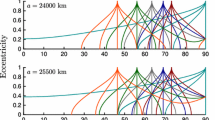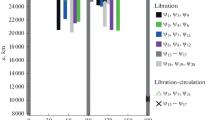Abstract
In this study, a dynamical model is developed to describe the secular evolution of navigation satellites under the geocentric reference frame with the Laplace orbit as the fundamental plane. The disturbing function, involving the effects of Earth’s oblateness and lunisolar gravitational attraction, is averaged over the orbital periods of both the satellite and the perturbers. In the regions of medium-Earth orbits and geosynchronous orbits, there are varieties of lunisolar resonances for governing the secular dynamics of navigation satellites. Among these resonances, we are interested in the ones occurring at the critical inclinations as well as the lunar node resonances. For each resonance of interest, the resonant center and width are identified analytically. Finally, dynamical maps are compared with the analytical results.

Similar content being viewed by others
References
Alessi, E. M., Rossi, A., Valsecchi, G. B., Anselmo, L., Pardini, C., Colombo, C., Lewis, H. G., Daquin, J., Deleflie, F., Vasile, M. et al. Effectiveness of GNSS disposal strategies. Acta Astronautica, 2014, 99: 292–302.
Allan, R. R., Cook, G. E. The long-period motion of the plane of a distant circular orbit. Proceedings of the Royal Society of London Series A Mathematical and Physical Sciences, 1964, 280(1380): 97–109.
Circi, C., Condoleo, E., Ortore, E. Moon’s influence on the plane variation of circular orbits. Advances in Space Research, 2016, 57(1): 153–165.
Ulivieri, C., Circi, C., Ortore, E., Bunkheila, F., Todino, F. Frozen orbital plane solutions for satellites in nearly circular orbit. Journal of Guidance, Control, and Dynamics, 2013, 36(4): 935–945.
Zhu, T. L. On the lunar node resonance of the orbital plane evolution of the Earth’s satellite orbits. Advances in Space Research, 2018, 61(11): 2761–2776.
Breiter, S. Lunisolar resonances revisited. In: Dynamics of Natural and Artificial Celestial Bodies. Pretka-Ziomek, H., Wnuk, E., Seidelmann, P. K., Richardson, D. L., Eds. Dordrecht: Springer Netherlands, 2001: 81–91.
Rosengren, A. J., Alessi, E. M., Rossi, A., Valsecchi, G. B. Chaos in navigation satellite orbits caused by the perturbed motion of the Moon. Monthly Notices of the Royal Astronomical Society, 2015, 449(4): 3522–3526.
Daquin, J., Rosengren, A. J., Alessi, E. M., Deleflie, F., Valsecchi, G. B., Rossi, A. The dynamical structure of the MEO region: Long-term stability, chaos, and transport. Celestial Mechanics and Dynamical Astronomy, 2016, 124(4): 335–366.
Todorović, N., Novaković, B. Testing the FLI in the region of the Pallas asteroid family. Monthly Notices of the Royal Astronomical Society, 2015, 451(2): 1637–1648.
Gkolias, I., Daquin, J., Gachet, F., Rosengren, A. J. From order to chaos in Earth satellite orbits. The Astronomical Journal, 2016, 152(5): 119.
Rosengren, A. J., Daquin, J., Tsiganis, K., Alessi, E. M., Deleflie, F., Rossi, A., Valsecchi, G. B. Galileo disposal strategy: Stability, chaos and predictability. Monthly Notices of the Royal Astronomical Society, 2017, 464(4): 4063–4076.
Sanchez, D. M., Yokoyama, T., de Almeida Prado, A. F. B. Study of some strategies for disposal of the GNSS satellites. Mathematical Problems in Engineering, 2015, 2015: 1–14.
Tang, J. S., Hou, X. Y., Liu, L. Long-term evolution of the inclined geosynchronous orbit in Beidou Navigation Satellite System. Advances in Space Research, 2017, 59(3): 762–774.
Lei, H. L. Dynamical models for secular evolution of navigation satellites. Astrodynamics, 2020, 4(1): 57–73.
Yokoyama, T. Dynamics of some fictitious satellites of Venus and Mars. Planetary and Space Science, 1999, 47(5): 619–627.
Lane, M. T. On analytic modeling of lunar perturbations of artificial satellites of the earth. Celestial Mechanics and Dynamical Astronomy, 1989, 46(4): 287–305.
Lei, H. L., Circi, C., Ortore, E. Modified double-averaged Hamiltonian in hierarchical triple systems. Monthly Notices of the Royal Astronomical Society, 2018, 481(4): 4602–4620.
Cook, G. E. Luni-solar perturbations of the orbit of an earth satellite. Geophysical Journal of the Royal Astronomical Society, 1962, 6(3): 271–291.
Hughes, S. Earth satellite orbits with resonant lunisolar perturbations I. Resonances dependent only on inclination. Proceedings of the Royal Society of London A Mathematical and Physical Sciences, 1980, 372(1749): 243–264.
Zhao, C. Y., Zhang, M. J., Wang, H. B., Xiong, J. N., Zhu, T. L., Zhang, W. Analysis on the long-term dynamical evolution of the inclined geosynchronous orbits in the Chinese BeiDou navigation system. Advances in Space Research, 2015, 56(3): 377–387.
Ely, T. A., Howell, K. C. Dynamics of artificial satellite orbits with tesseral resonances including the effects of luni-solar perturbations. Dynamics and Stability of Systems, 1997, 12(4): 243–269.
Brouwer, D. Solution of the problem of artificial satellite theory without drag. The Astronomical Journal, 1959, 64: 378.
Kozai, Y. Secular perturbations of asteroids with high inclination and eccentricity. The Astronomical Journal, 1962, 67: 591.
Deprit, A. Canonical transformations depending on a small parameter. Celestial Mechanics, 1969, 1(1): 12–30.
Hori, G. Theory of general perturbation with unspecified canonical variable. Publication of the Astronomical Society of Japan, 1966, 18(4): 287.
Celletti, A., Galeş, C. B. A study of the lunisolar secular resonance \(2\dot \omega + \dot \Omega = 0\). Frontiers in Astronomy and Space Sciences, 2016, 3: 11.
Naoz, S. The eccentric kozai-lidov effect and its applications. Annual Review of Astronomy and Astrophysics, 2016, 54(1): 441–489.
Chirikov, B. V. A universal instability of many-dimensional oscillator systems. Physics Reports, 1979, 52(5): 263–379.
Gkolias, I., Colombo, C. Towards a sustainable exploitation of the geosynchronous orbital region. Celestial Mechanics and Dynamical Astronomy, 2019, 131(4): 1–30.
Acknowledgements
This work was performed with the financial support of the National Natural Science Foundation of China (No. 12073011).
Author information
Authors and Affiliations
Corresponding author
Additional information
Hanlun Lei received his Ph.D. degree in astronomy from Nanjing University, China, in 2015. Currently, he is an associate professor at the School of Astronomy and Space Science in Nanjing University. His research interest focuses on astrodynamics and celestial mechanics, including space manifold dynamics in multi-body environments as well as resonance dynamics of minor bodies.
Emiliano Ortore graduated in aerospace engineering (M.S. degree) and astronautical engineering (M.S. degree) and pursued his Ph.D. degree in aerospace engineering at Sapienza University of Rome. Since 2004, he has been working as a researcher at Sapienza University of Rome. His research fields are celestial mechanics, orbits and satellite constellations for Earth observation, telecommunication and navigation, orbits for the observation of planets, moons, and asteroids, and remote sensing applications.
Christian Circi is currently an associate professor in flight mechanics at the Department of Astronautical, Electrical and Energy Engineering, Sapienza University of Rome. He received his M.S. degrees in aeronautical engineering and aerospace engineering, and pursued his Ph.D. degree in aerospace engineering at Sapienza University of Rome. He worked as a researcher at the Grupo de Mecanica of Vuelo-Madrid (GMV), and a research assistant at the Department of Aerospace Engineering. He lecturers “interplanetary trajectories” and “flight mechanics of launcher” in the master degree course of space and astronautical engineering at Sapienza University of Rome. His principal research fields are as follows: third-body and solar perturbations, interplanetary and lunar trajectories, solar sail, orbits for planetary observation, and ascent trajectory of Launcher. He is an associate editor for the journals of Aerospace Science and Technology and the International Journal of Aerospace Engineering.
Rights and permissions
About this article
Cite this article
Lei, H., Ortore, E. & Circi, C. Secular dynamics of navigation satellites in the MEO and GSO regions. Astrodyn 6, 357–374 (2022). https://doi.org/10.1007/s42064-021-0110-4
Received:
Accepted:
Published:
Issue Date:
DOI: https://doi.org/10.1007/s42064-021-0110-4




